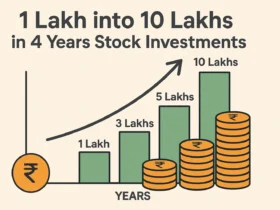Hey, students! 🌟 Are you ready to turn your spare change into a financial empire? You might be thinking, “Investment? Isn’t that for rich people with briefcases and private jets?” Nope! Investing is for anyone with a dream and a few bucks to spare—yes, even you, juggling classes, part-time jobs, and a ramen noodle budget. As a student, you’ve got something more valuable than money: time. And with the right investment plan, that time can transform into wealth.
Why Investing as a Student is a Game-Changer
You’re 20 years old, sipping coffee in your dorm, and you decide to invest $50. Fast forward 40 years, and that $50 has ballooned into thousands—without you lifting a finger. How? Two words: compound interest. It’s like a snowball rolling downhill, growing bigger with every turn. The earlier you start, the more time your money has to multiply.
Table of Contents
Here’s a quick example to blow your mind: If you invest $100 at age 20 with a 7% annual return, it could grow to over $1,400 by age 60. Wait until you’re 30 to invest that same $100, and it’s only $700 by 60. That’s double the payoff just for starting a decade earlier! Time is your superpower, and investing now lets you harness it.
“Compound interest is the eighth wonder of the world. He who understands it, earns it; he who doesn’t, pays it.” — Albert Einstein (allegedly)
Table 1: The Power of Starting Early
| Age You Start | Amount Invested | Annual Return | Value at Age 60 |
|---|---|---|---|
| 20 | $100 | 7% | $1,400 |
| 30 | $100 | 7% | $700 |
| 40 | $100 | 7% | $350 |
So, even if you’re scraping by on a student budget, small investments now can pay off big later. Ready to find the perfect plan for you? Let’s explore your options!

The Best Investment Plans for Students
Here’s the lineup of the top investment plans tailored for students. We’ll cover what they are, their perks, their pitfalls, and who they’re best for—complete with tables, bullet points, and a dash of humor to keep things lively.
1. High-Yield Savings Accounts: The Safety Net
What It Is: A savings account with a higher interest rate than your standard bank account—think of it as a piggy bank with a turbo boost.
Pros:
- Super Safe: Your money’s insured (up to $250,000 in the U.S.), so no sleepless nights.
- Easy Access: Need cash for a last-minute textbook? You’ve got it.
- Low Entry: Start with as little as $1.
Cons:
- Low Returns: You won’t get rich quick—think 3-5% annually at best.
- Inflation Risk: Returns might not keep up with rising prices.
Best For: Students who want a secure spot for emergency funds or short-term savings.
“A high-yield savings account is like a cozy blanket for your money—safe and warm, but don’t expect it to turn into a cashmere sweater overnight.” — Anonymous Financial Blogger
2. Index Funds: The Lazy Genius Option
What It Is: A type of investment that tracks a market index (like the S&P 500), pooling your money into hundreds of companies at once.
Pros:
- Diversification: One investment, tons of companies—less risk if one tanks.
- Low Fees: Cheaper than hiring a Wall Street hotshot.
- Solid Returns: Historically, the S&P 500 averages 7-10% annually.
Cons:
- Market Risk: If the market dips, so does your investment.
- Patience Required: This is a long-term play.
Best For: Students who want growth without the hassle.
Bullet Points: Why Index Funds Rock
- Set It and Forget It: Minimal management needed.
- Low Cost: Fees as low as 0.04% per year.
- Proven Track Record: Decades of data show steady growth.
3. Robo-Advisors: Your Personal Money Robot
What It Is: An app or platform that builds and manages your investment portfolio based on your goals and risk tolerance.
Pros:
- User-Friendly: Perfect for beginners—no finance PhD required.
- Low Minimums: Start with $5 or even $0 on some platforms.
- Hands-Off: The robot does the heavy lifting.
Cons:
- Fees: Typically 0.25% annually—higher than self-managed options.
- Less Control: You’re trusting an algorithm.
Best For: Students who want investing on autopilot.
Table 2: Popular Robo-Advisors for Students
| Robo-Advisor | Minimum Investment | Annual Fee | Cool Feature |
|---|---|---|---|
| Betterment | $0 | 0.25% | Tax-loss harvesting |
| Wealthfront | $500 | 0.25% | College savings tools |
| Acorns | $5 | $1/month | Rounds up spare change |
4. Individual Stocks: The Thrill-Seeker’s Choice
What It Is: Buying shares of a single company—like owning a tiny piece of Apple or Tesla.
Pros:
- High Potential: Big wins if the company soars.
- Educational: Learn the stock market hands-on.
- Fun Factor: Brag to your friends about your stock picks.
Cons:
- High Risk: One bad quarter, and your investment’s toast.
- Time-Intensive: Research is a must.
Best For: Students ready to roll up their sleeves and take risks.
Tip: Start with companies you know—like that coffee chain you hit daily. Just don’t bet the farm on one stock!
5. Mutual Funds: The Team Effort
What It Is: A pool of money from many investors, managed by pros who pick the stocks or bonds.
Pros:
- Diversification: Spreads risk across dozens of assets.
- Expert Management: Someone smarter than us is in charge.
Cons:
- Higher Fees: Often 1% or more annually.
- Performance Varies: Some managers underperform the market.
Best For: Students who trust the pros and want variety.
6. Bonds: The Steady Eddie

What It Is: A loan to a government or company that pays you interest over time.
Pros:
- Safer Than Stocks: Less rollercoaster vibes.
- Predictable Income: Regular interest payments.
Cons:
- Lower Returns: Think 2-5% annually.
- Complexity: Terms like “yield to maturity” can confuse.
Best For: Risk-averse students diversifying their stash.
7. Cryptocurrencies: The Wild Card
What It Is: Digital currencies like Bitcoin or Ethereum—think internet money with a rebellious streak.
Pros:
- Sky-High Potential: Some early investors became millionaires.
- Decentralized: No banks, just you and the blockchain.
Cons:
- Insane Volatility: Prices can crash overnight.
- Risky: Scams and hacks are real threats.
Best For: Adventurous students with cash they can afford to lose.
Warning: Crypto’s like riding a rollercoaster blindfolded—thrilling but dicey. Start small if you dare!
How to Pick the Perfect Plan for You
So, which is the best? It’s like choosing between pizza and tacos—depends on your vibe. Here’s how to decide:
Questions to Ask Yourself
- What’s My Goal? Saving for a laptop next semester? Or retirement in 40 years?
- How Much Risk Can I Handle? Are you cool with ups and downs, or do you need stability?
- How Much Time Do I Have? Want to set it and forget it, or dive into research?
Match Your Answers
- Short-Term + Low Risk: High-yield savings accounts or bonds.
- Long-Term + Medium Risk: Index funds or robo-advisors.
- Learning + High Risk: Individual stocks or a sprinkle of crypto.
Still unsure? Mix and match! Put some cash in a savings account for emergencies and some in an index fund for growth. It’s your money, your rules.
Real Students, Real Wins
Need proof this works? Meet some students who turned small investments into big wins.
Sarah, the Index Fund Fan
Sarah, a 19-year-old biology major, started investing $25 a month in an index fund via a robo-advisor. Two years later, she had $700—enough to cover a summer trip. “It felt like free money,” she says. “I just let it grow while I studied.”
Mike, the Stock Picker
Mike, a 21-year-old business student, saved $300 from his barista gig and bought shares in a tech company he loved. Three years later, his portfolio was worth $450. “It’s not just profit,” he says. “It’s learning how money works.”
“Investing isn’t about getting rich quick—it’s about building habits that last a lifetime.” — Mike, Student Investor
Pro Tips to Kickstart Your Investing Journey
Ready to jump in? Here’s your cheat sheet:
- Start Small: Even $5 a month counts.
- Automate It: Set up recurring deposits to stay consistent.
- Educate Yourself: Podcasts, YouTube, and books are your friends.
- Diversify: Don’t put all your cash in one place.
- Be Patient: Wealth builds over years, not days.

Conclusion: Your Future Starts Now
Investing as a student isn’t just about money—it’s about taking control of your future. Whether you go for the safety of a high-yield savings account, the ease of a robo-advisor, or the thrill of stocks, the key is to start today. Time’s ticking, and every dollar you invest now is a seed for tomorrow’s harvest. So, what are you waiting for? Grab your phone, pick a plan, and let’s grow that wealth together! 🌱
FAQ: Your Burning Questions Answered
Q: How much money do I need to start investing?
A: As little as $1! Platforms like Acorns or Stash let you begin with pocket change.
Q: Is investing risky for students?
A: Yes, but it varies. Savings accounts are low-risk; crypto’s high-risk. Pick what fits your comfort zone.
Q: Can I lose all my money?
A: Possible with stocks or crypto, but unlikely with diversified options like index funds. Spread your bets!
Q: Should I invest or pay off student loans first?
A: Compare interest rates. If your loan’s at 6% and investments earn 7%, investing might edge out. Otherwise, tackle debt.
Q: How do I learn more?
A: Check out “The Simple Path to Wealth” by JL Collins, or YouTube channels like Graham Stephan. Start simple!


























Leave a Reply